Bread-making and -breaking
Bread-making and -breaking
-
-
-
-
-
Bread-making and -breaking
-
Post #1 - February 13th, 2006, 11:43 amI love bread. I really do. And making my own bread has been one of those things that I’ve always wanted to do – even stating my intentions out loud to anybody who’d listen. But it was only recently that I actually resolved to get off my duff and actually do something about it.
So with a recent holiday gift card, I purchased Peter Reinhart’s The Bread Baker’s Apprentice: Mastering the Art of Extraordinary Bread. After getting the book and flipping through its extensive (yet accessible) bread theory/method and color photos, I thought: “Huh, it’s pretty, but will I use it?” And then off and on for about a week, I started reading through. I was slightly intimidated by the fact that most recipes called for a two day timeline. But there it was: a 12-step process for making bread and a primer on the bread maker’s math (still learning this).
So a couple of weekends ago, I decided to try his pain l’ancienne. This is a basic, rustic dough, made only with bread flour, yeast, water, and a little salt. What intrigued me about this was Reinhart’s description of this cold-dough delayed fermentation formula. The dough is combined using ice cold water and placed in the fridge (day 1). And then proofs at room temperature. This combination, along with following Reinhart’s suggestions for producing steam in the early minutes of baking, produced some of the best baguettes I’ve ever tasted. Irregular holes surrounded by an excellent crust. We polished off two of these (below) within a matter of minutes. I was a little over-aggressive in flouring these, but the excess dusted right off:
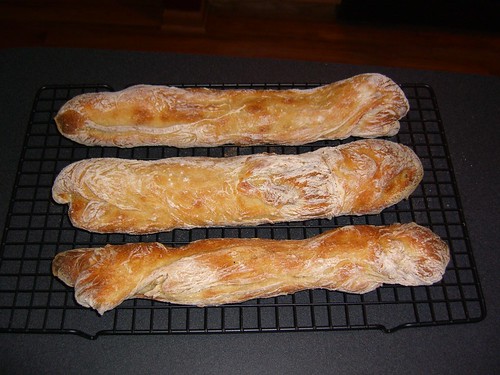
I kept leftover dough in the freezer and used it to make Neapolitan-style pizza, per Reinhart’s suggestion. The edges turned out puffier than I might’ve liked, but the taste was great, topped with some leftover pesto, goat cheese, and tomatos.
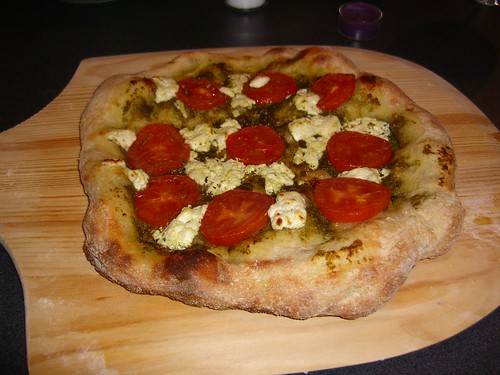
This past weekend, I tried my hand at some challah. Surprising to me, this was a pretty easy one day procedure. Here’s the braid, prior to going into the oven:
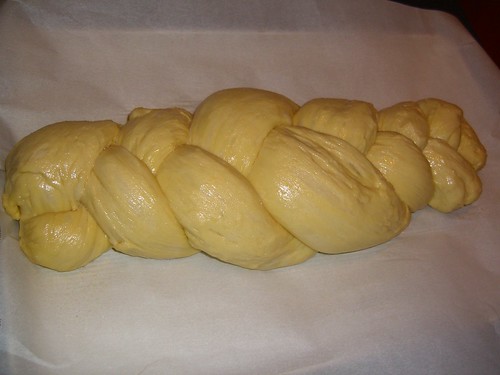
The finished product:
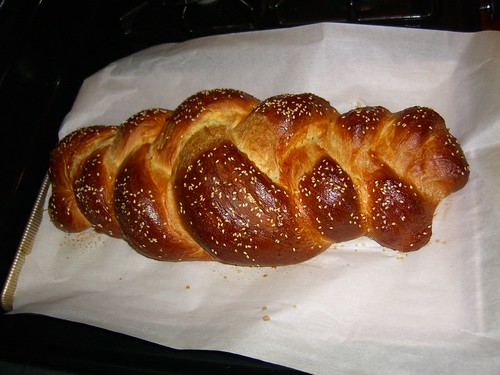

I’m not an challah expert by any stretch, but this was pretty good. Not as eggy or sweet as I’ve had in the past, but there’s room for tinkering. No picture, but this made a mean French toast, too.
So that I don’t keep kicking up flour dust, I’m restricting myself to biweekly baking for now. Going to move up to biga and poolish starter-breads in upcoming weeks.
Why did I wait this long to get kneading?Last edited by Zeeshan on February 13th, 2006, 12:26 pm, edited 2 times in total.
-
-
Post #2 - February 13th, 2006, 12:41 pmZeeshan:
Very nice post, very nice bread, with and without stuff on it. With the pizza crust, you need to get the edge pretty small in the raw state and it comes back then to a reasonable size, at least as I think of it... see photos in pizza posts listed here for what I think of as a reasonable outer edge:
http://lthforum.com/bb/viewtopic.php?p=55649#55649
The Reinhart book is great (thanks to Mr. Bruck for introducing me to his writing), indeed, and I find the cold-dough idea interesting. It all comes down to what Frank Masi always tells me... controll the fermentation... Slow is good.
Are you using a stone?
AntoniusAlle Nerven exzitiert von dem gewürzten Wein -- Anwandlung von Todesahndungen -- Doppeltgänger --
- aus dem Tagebuch E.T.A. Hoffmanns, 6. Januar 1804.
________
Na sir is na seachain an cath.
-
-
Post #3 - February 13th, 2006, 12:47 pmInspiring!
This is an example of why people love to read this site (and put up with minor sqaubbles from time to time).
I have threatened to become a bread baker on several occasions. However, as a single guy, I am afraid I would have just that many more mistakes to eat. This may be the post that sets me over the edge.
This may be the post that sets me over the edge.
Regards,
PeterUnchain your lunch money!
-
-
Post #4 - February 13th, 2006, 1:52 pmI've been going on this year on how I'm going to get more into baking bread. I haven't done much with that honestly. I've had a few failed attempts. However the recent purchase of a baking stone I believe is going to set me off in the right direction.
Your bread looks lovely.
-
-
Post #5 - February 13th, 2006, 2:03 pmMrsF also loves this book, and Breads from the LaBrea Bakery, as her top sources for from-scratch, you'd-better-not-expect-bread-tonight loaves.
Nothing like a long-rising bread for flavor. The challah was wonderful, although their weaving instructions could use a little more detail. Once we figured it out we were OK, but we botched it three times before it started making sense.
The LaBrea book has the loaves that Jewel has been carrying, including that stupendous olive loaf. It's even better hot from your own oven.What is patriotism, but the love of good things we ate in our childhood?
-- Lin Yutang
-
-
Post #6 - February 13th, 2006, 2:14 pmpdaane wrote:Inspiring!
I'll second that thought.
However, up until now, I've been skeptical that quality baguettes can be made at home. You have singlehandedly erased that cul-de-sac in my culinary aspirations, reminding me that one must dream to live. Thanks, Zeeshan.Man : I can't understand how a poet like you can eat that stuff.
T. S. Eliot: Ah, but you're not a poet.
-
-
Post #7 - February 13th, 2006, 3:24 pmJoelF wrote:The LaBrea book has the loaves that Jewel has been carrying, including that stupendous olive loaf. It's even better hot from your own oven.
This is especially the case since La Brea was acquired by Irish food conglomerate IAWS and they started "par-baking" their loaves to allow for international distribution. Don't get me wrong - I find the La Brea line to be quite acceptable for supermarket bread. But the homemade olive loaf - which takes about 18 hours to make and rise - is hands down one of the best loaves of bread I've ever eaten.
http://www.checkout.ie/Feature.asp?ID=215
Fillay
-
-
Post #8 - February 13th, 2006, 3:34 pmAntonius wrote:With the pizza crust, you need to get the edge pretty small in the raw state and it comes back then to a reasonable size, at least as I think of it... see photos in pizza posts listed here for what I think of as a reasonable outer edge:
http://lthforum.com/bb/viewtopic.php?p=55649#55649
[snipped]
Are you using a stone?
Thanks for your suggestion, Antonius -- I'm with you re: size of a reasonable crust. I'd always assumed I needed to give a little more dough at the edge to create the crust. While the crust was a bit bulky, the main part of the pie was nice and thin. I think I'll need a couple dozen more pizzas under my belt before I get the edges to turn out quite right.
For the pizza, yes, a stone. Specifically, I used a stone on the lowermost rack. Oven preheated for 30 mins to 550 (not independently tested with thermometer). 180 degree turn after 2 mins and then about 5-7 minutes. While the pizza doneness is perfect to me with this baking environment, it's creating a nuisance amount of smoke from burning cornmeal (for peel to stone transfer). Next time I might try a 500 or 475 deg oven?
Zeeshan
PS: Thanks for kind words all. This has been one of the most satisfying experiments I've ever undertaken.Last edited by Zeeshan on February 13th, 2006, 3:44 pm, edited 1 time in total.
-
-
Post #9 - February 13th, 2006, 3:39 pmJoelF wrote:Nothing like a long-rising bread for flavor. The challah was wonderful, although their weaving instructions could use a little more detail. Once we figured it out we were OK, but we botched it three times before it started making sense.
Joel,
I had a similar experience with his description of the braiding technique. It was a relatively minor blemish on the recipe, which otherwise seemed on target. And after a few headscratching moments, I just tried to forget it was dough, and for whatever reason, that seemed to work.
Zee
-
-
Post #10 - February 13th, 2006, 4:26 pmZeeshan wrote:...it's creating a nuisance amount of smoke from burning cornmeal (for peel to stone transfer). Next time I might try a 500 or 475 deg oven?
Zeeshan,
You might want to try semolina instead of cornmeal. Less needed, less burning, not acrid. I use it on the deck of my oven at 800F.
Bill/SFNM (a kindred baking fanatic)Last edited by Bill/SFNM on February 13th, 2006, 4:53 pm, edited 1 time in total.
-
-
Post #11 - February 13th, 2006, 4:40 pmBill - what kind of oven do you have?CONNOISSEUR, n. A specialist who knows everything about something and nothing about anything else.
-Ambrose Bierce, The Devil's Dictionary
www.cakeandcommerce.com
-
-
Post #12 - February 13th, 2006, 4:54 pmQueijo wrote:Bill - what kind of oven do you have?
Wood-burning brick oven.
Bill/SFNM
-
-
Post #13 - February 13th, 2006, 5:02 pmIs it outside or inside? did you build it yourself?CONNOISSEUR, n. A specialist who knows everything about something and nothing about anything else.
-Ambrose Bierce, The Devil's Dictionary
www.cakeandcommerce.com
-
-
Post #14 - February 13th, 2006, 5:35 pmQueijo wrote:Is it outside or inside? did you build it yourself?
Outside. Built it myself using a kit from Earthstone. Use it ~3 times per week for pizza and bread.
Bill/SFNM
-
-
Post #15 - February 13th, 2006, 5:40 pmBill/SFNM wrote:Queijo wrote:Is it outside or inside? did you build it yourself?
Outside. Built it myself using a kit from Earthstone. Use it ~3 times per week for pizza and bread.
Bill/SFNM
Wow, Bill. That's quite a commitment. And probably pretty adaptive for NM weather?
What kinds of breads are you making?
Zee
-
-
Post #16 - February 13th, 2006, 6:33 pmZeeshan wrote:
What kinds of breads are you making?
Pizzas, baguettes, focaccia,, bagels, etc. Been having fun with highly hydrated doughs (65%-75% water - Baker's %) that produce amazingly light and airy breads. These days I have pretty much eliminated commercial yeast from all my breads, using natural starter cultures that add all kinds of interesting flavors and respond beautifully to different feeding, fermentation and proofing schedules. I am so hooked on baking breads, don't get me started. Too late.
Bill/SFNM
-
-
Post #17 - February 25th, 2006, 11:38 amFrom a different book, this week I was hoping to make pucce, an olive-studded loaf. The recipe calls for coarse semolina (not semolina flour), but I haven't been able to find this in any of my usual grocers.
Does anybody have a local source they can share?
z
-
-
Post #18 - February 25th, 2006, 1:49 pmAny of the small italian grocery stores should have it. I know Bari has it in 1kg bags for sure.
-
-
Post #19 - February 25th, 2006, 4:58 pmZeeshan wrote:From a different book, this week I was hoping to make pucce, an olive-studded loaf. The recipe calls for coarse semolina (not semolina flour), but I haven't been able to find this in any of my usual grocers.
Does anybody have a local source they can share?
z
Salumerie around town carry it but if you want it in larger quantities and/or at a better price, go to Graziano's:
http://lthforum.com/bb/viewtopic.php?p=25595#25595
All Arab and Greek groceries (e.g. Athens Market) carry it as well.
AntoniusAlle Nerven exzitiert von dem gewürzten Wein -- Anwandlung von Todesahndungen -- Doppeltgänger --
- aus dem Tagebuch E.T.A. Hoffmanns, 6. Januar 1804.
________
Na sir is na seachain an cath.
-
-
Post #20 - February 26th, 2006, 3:21 pmgleam wrote:Any of the small italian grocery stores should have it. I know Bari has it in 1kg bags for sure.
Thanks, Ed & Antonius. We found 1lb bags of semolina ($0.69/lb) at Bari today (first visit). In their small space, they pack a good amount of variety. And the deli atmosphere and sandwiches made my wife nostalgic for her Staten Island youth.
At the risk of getting sentimental myself, I find myself thankful for LTH slowly but surely opening my eyes (and gut) to Chicago.
Next up: pucce and focaccia.
z
-
-
Post #21 - February 28th, 2006, 11:02 pmHere's the latest (and last-to-be-documented) round of bread.
****
Reinhart's focaccia is pretty simple, but quite tasty. Instead of using the single batch to make one pan (1/2 sheet) of bread, I split the dough in two. Made one yesterday and holding the other for another day.
Here's one of the pans at the proofing stage, with quite a bit of oil previously steeped with basil, oregano, rosemary and garlic:
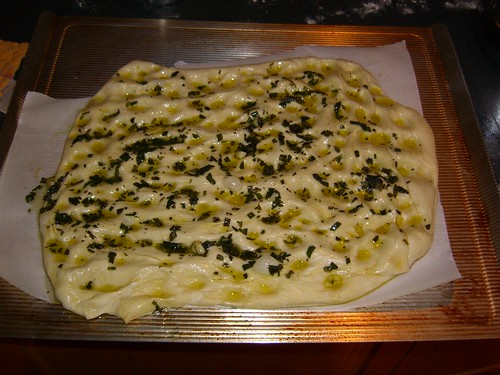
After a quick 20 mins in the oven, cooked on the pan:
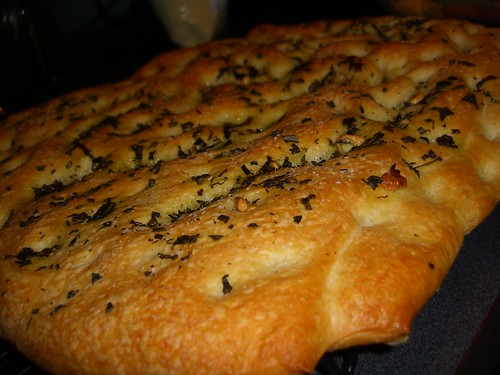
And then cut up:
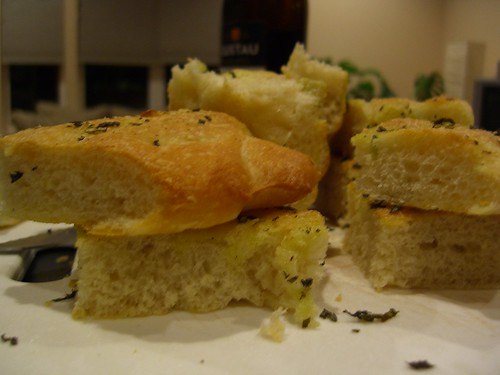
It was a tasty bread, guaranteed to grease up your fingers. I'd probably cut a *little* oil next time and throw on a few toppings.
Made a biga (starter) a couple of days ago for today's pucce, which I made with a mixture of black and green olives.
If any doubt, here's evidence that's we're dealing with living stuff here (1.5 day old biga):
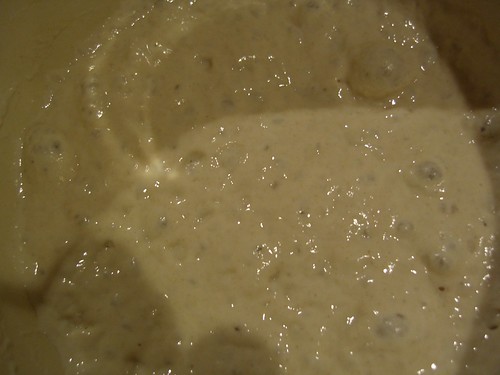
The pucce as low rolls turned out pretty well (cooked on a stone):
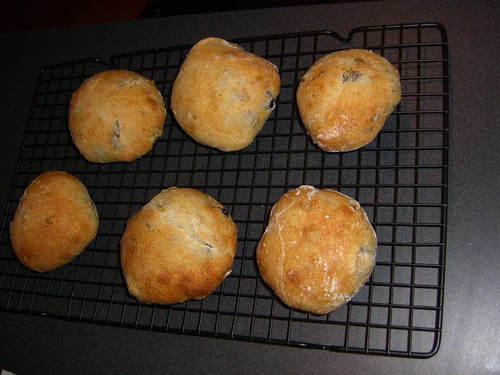
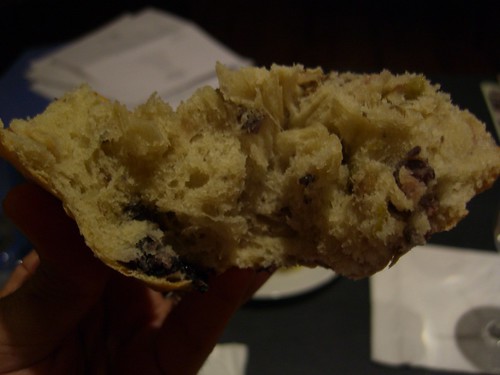
As did the loaf version, even though it probably could've stayed in for a minute or two longer:
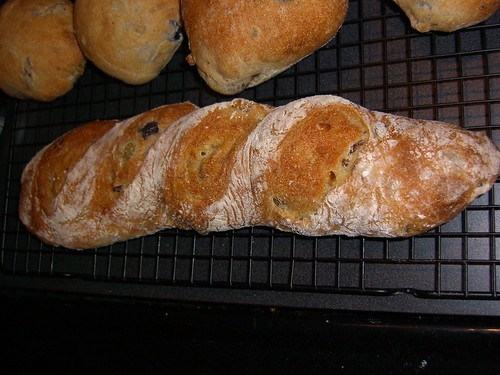
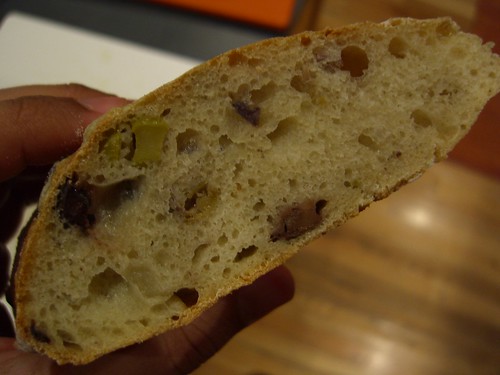
The warm rolls were hearty and subtantial, but didn't convey much olive taste until allowed to cool completely.
***
So, sure, I'm a proud dad. But I don't put these up as the end-all of breads. They are testament, though, to the fact that a good cookbook and a dough scraper can be a big motivator. Until I get a backyard to make an oven like Bill, I'll amuse myself by playing around with formulas and shaping dough.
Zee
-
-
Post #22 - February 28th, 2006, 11:57 pmThose are damn nice looking breads, Zeeshan.
I've been sort of discouraged about bread after reading a review in The Art of Eating of several bread books which basically expressed utter hopelessness toward most of them and made the rest sound impossibly hard (apparently you need to keep your dough between 51.4 and 51.7 degrees for exactly 94 minutes and 11 seconds, or you'll produce a mockery of French bread). You give me hope that, in fact, it may be possible for humans to make good bread.Watch Sky Full of Bacon, the Chicago food HD podcast!
New episode: Soil, Corn, Cows and Cheese
Watch the Reader's James Beard Award-winning Key Ingredient here.
-
-
Post #23 - March 1st, 2006, 3:28 pmMike G wrote:I've been sort of discouraged about bread after reading a review in The Art of Eating of several bread books which basically expressed utter hopelessness toward most of them and made the rest sound impossibly hard (apparently you need to keep your dough between 51.4 and 51.7 degrees for exactly 94 minutes and 11 seconds, or you'll produce a mockery of French bread).
This is where I'm still low on the learning curve. I don't have a good sense for how forgiving bread formulas are regarding deviations.
Why, for e.g., does Reinhart call for folding focaccia dough into thirds (like a letter), with specified rest times in between (30 - 60 mins)? Why not fold in half at 15 min intervals? For now, I act like a trained monkey and do what I'm told. And since the formulae work, I'm a little hesitant to deviate from them.
Then again, if I wanted to be super-fussy about all this, shouldn't I have taken up baking pastries and other sweets, where OCD-precision is rewarded in spades? But hey, the French do make great bread.
Zee
-
-
Post #24 - March 1st, 2006, 5:03 pmEverytime you bake a loaf following other's formulas and procedures, you will come to better know your dough and develop a more intimate relationship with it (note my restaint
 ). Take careful notes (too dry, too salty) and make slight changes with each batch, zig-zagging your way forward (sometimes backwards) until you reach the loaf that you can't stop thinking about at night (more restraint).
). Take careful notes (too dry, too salty) and make slight changes with each batch, zig-zagging your way forward (sometimes backwards) until you reach the loaf that you can't stop thinking about at night (more restraint).
What works for brother Reinhart doesn't work for me. Flour types, water temps, water chemistry, altitude, ovens, yeast strains, weather, all need to be learned and exploited. The good news is that the window isn't as small as Mike G says. It isn't hard to make a great loaf, but you need to be dedicated to the quest and willing to eat or toss your mistakes in order to learn.
Bill/SFNM (still learning)
-
-
Post #25 - March 1st, 2006, 5:37 pmBy the way, I note that that article absolutely trashes Reinhart's book.
Track it down and read it, it'll depress you for a week.Watch Sky Full of Bacon, the Chicago food HD podcast!
New episode: Soil, Corn, Cows and Cheese
Watch the Reader's James Beard Award-winning Key Ingredient here.
-
-
Post #26 - March 1st, 2006, 6:07 pmTwo of my best breads (challah and bagels) originated as Reinhart recipes. But they have been tweaked so much over the years that they now bare no resemblance to the original.
I took a class from Reinhart and was impressed with his skill, knowledge, and love of bread. His 1991 book, Brother Juniper's Bread Book, Slow Rise as Method and Metaphor, is a treasure.
I'll hunt down that article. Thanks.
Bill/SFNM
-
-
Post #27 - March 2nd, 2006, 9:30 amMike G wrote:Track it down and read it, it'll depress you for a week.
Ha! I can hardly wait!
I've heard of tAoE somewhere (probably here), but haven't seen it on a rack as yet. For other who may be looking, it looks like the set of reviews Mike's referring to are in the current issue:no. 70 CURRENT ISSUE "Gruyère de Comté" — addresses in the Franche-Comté — Tropical Fruit in Homestead, Florida — Science and the Pursuit of a Perfect Hard-Cooked Egg, Roast Chicken, and Flaky Pie Crust — Vegetables in Italy — recipes — notes and resources (dried corn) — books: How-to Bread Books, Max McCalman's Cheese, Patience Gray's The Centaur's Kitchen, and John T. Edge's Fried Chicken, Apple Pie, and Hamburgers & Fries. 48 pp.
Bill -- I'm sure this is the beginning of a longer journey. I'm sure I'll start growing more comfortable playing around with others' formulas with some time. Besides Reinhart's books, are there others you'd (or others would) recommend for those looking to beef up on basics?
Zee
-
-
Post #28 - March 2nd, 2006, 9:44 amZeeshan wrote:
Besides Reinhart's books, are there others you'd recommend for those still learning?
Zee:
I started out with "Beard on Bread" back in the 70's. But it really depends on what type(s) of bread you are going for. "Baking with Julia" is also a good source.
But if were starting out, I would pick one type of bread and just focus on getting that to the "first" stage which is as good, if not better, than your local bakery. I started out with baguettes.
If you don't mind some unsolicited advice: If you are serious about this quest, it is essential to measure all of your ingredients by weight, so seek recipes that use Baker's % and get a good digital scale if you don't already have one. Standardize on one kind of flour, one kind of yeast, one kind of salt, one source of water. Sounds like a pain, but really isn't.
Bill/SFNM
-
-
Post #29 - March 2nd, 2006, 9:51 pmZeeshan wrote:Here's the latest (and last-to-be-documented) round of bread.
I certainly understand if you don't want to bother to continue documenting your breads, but I doubt I'm alone in saying I'd be happy to see you continue posting.
These look wonderful. Thanks, Zeeshan.
-
-
Post #30 - March 3rd, 2006, 8:14 amAaron Deacon wrote:Zeeshan wrote:Here's the latest (and last-to-be-documented) round of bread.
I certainly understand if you don't want to bother to continue documenting your breads, but I doubt I'm alone in saying I'd be happy to see you continue posting.
Thanks, Aaron. It was a bit ambiguous -- last forseeable bread documentation.
While I'm thinking of it, who does the intake interviews for LTH-dependence treatment?
z

